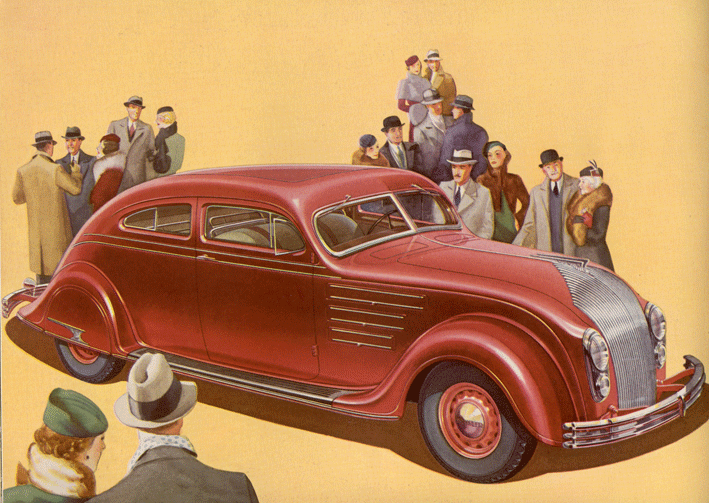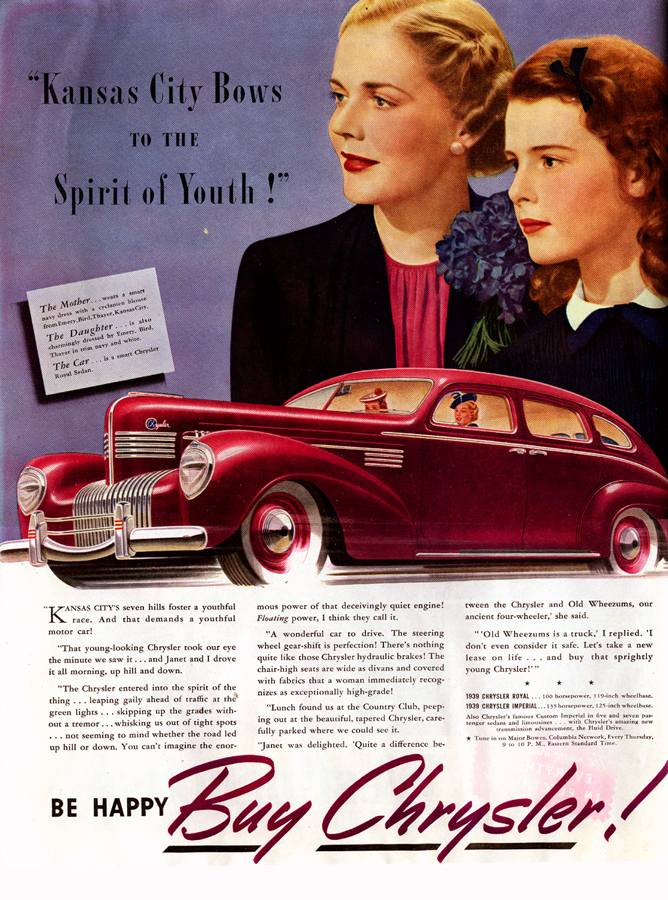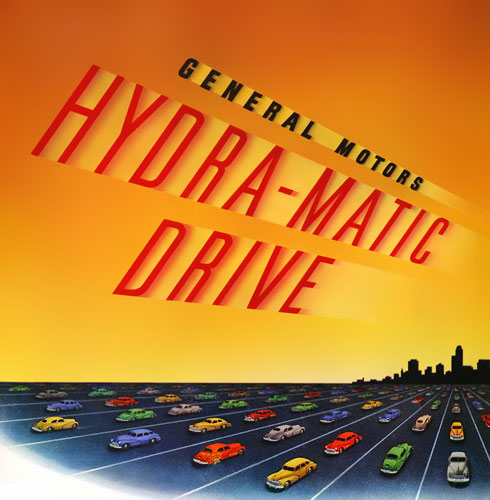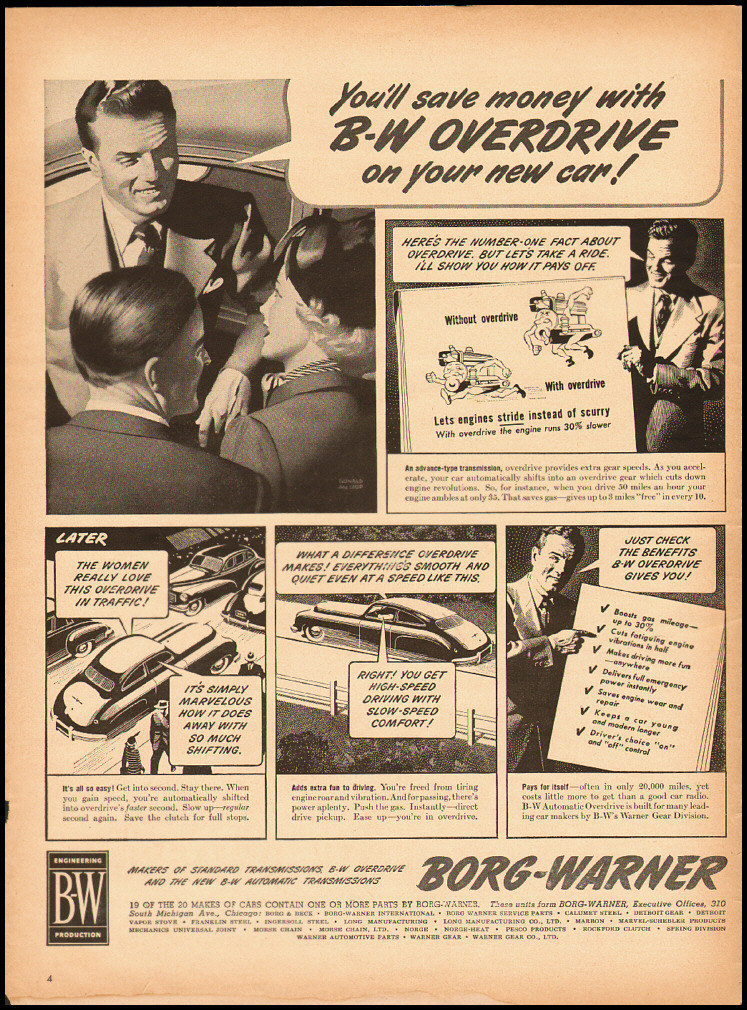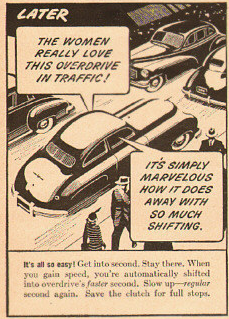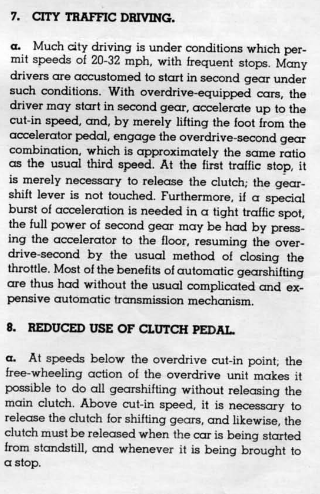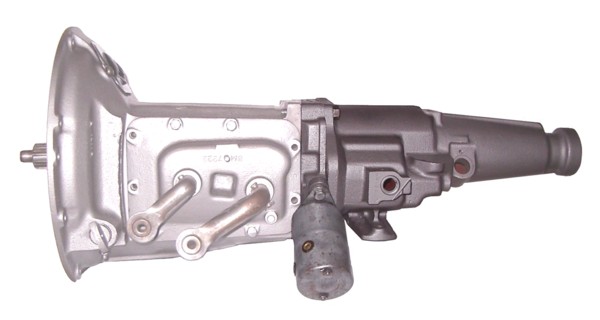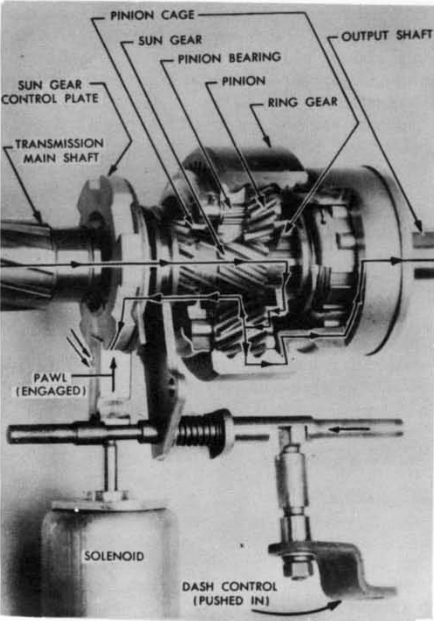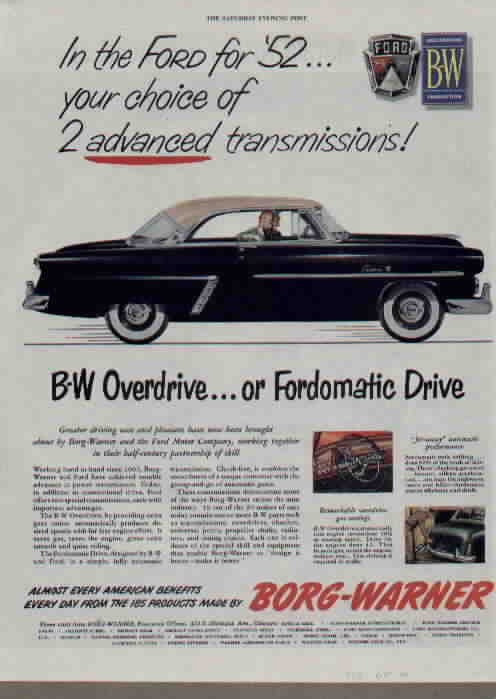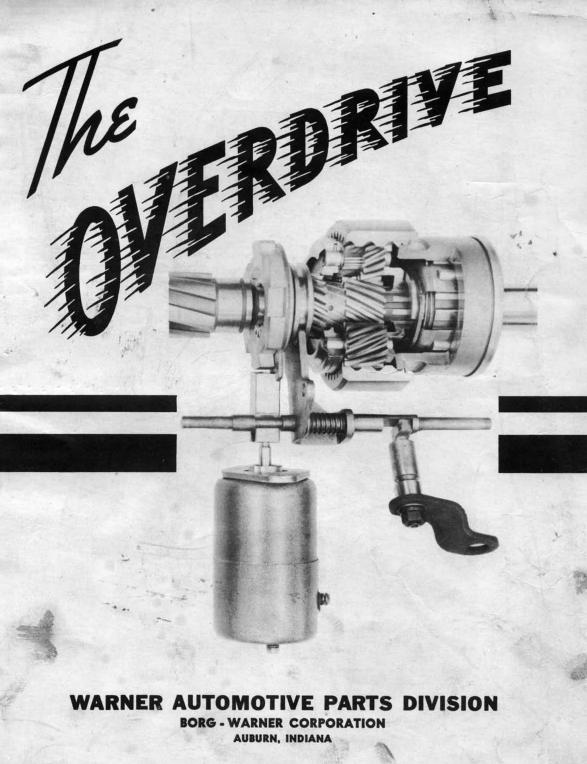(first posted 8/31/2012. Revised 6/6/2016) After mentioning underdrive as an integral feature of Chrysler’s Fluid-Drive semi-automatic transmission in the 1946 Town and Country, it might be appropriate to shed a bit of light on its over-achieving relative: Overdrive. For you younger readers, no, we’re not talking about the top gear in modern stick-shift or automatic transmissions. This is about epicyclic or planetary overdrive (not interstellar overdrive, which also has its joys), as pioneered by Borg-Warner in 1934, and available on various American cars and trucks with three-speed transmissions until 1972, when the last Ford pickup free-wheeled off the lines with one.
Borg-Warner’s “automatic” overdrive premiered on a car that was quite advanced and adventurous in other ways: the 1934 Chrysler and DeSoto Airflow. Allpar has this to say about the origins of the B-W OD:
The “fourth gear” using the (Rex) Keller clutch was invented by Chrysler, but to avoid $25,000 in tooling costs, Walter P. Chrysler chose to have Borg-Warner make and supply it. That meant that competitors could also buy the system (Breer book, p. 124),
It would be natural to assume that Chrysler chose to take of advantage of this new technology because of the Airflow’s other technical advances and presumed higher cruising speed, thanks to its aerodynamics. But there was also another one.
In the twenties through the forties, American cars (and their drive trains) were designed for the prevailing conditions, which were very different than more modern ones. Towns and cities were compact and dense. Everyone still knew how to parallel park, even. Trips were typically short, with lots of starts and stops.
And highways were narrow, often with steep grades and tight curves. Highway speeds were typically around 45 or 50. Higher speed parkways and throughways were just emerging in the largest cities. Cars were geared to these conditions, with very low (high numerical) rear axle ratios, typically between 4:1 and 5:1. Combined with long-stroke engines that preferred to run at low rpm, most cars really weren’t happy above 50 mph or so, except for short bursts.
The other key factor in drive train design was that transmissions were balky. Cadillac had the first syncromesh transmission in 1929–only on the second and third gears–and it eventually spread throughout the industry. Even with syncromesh, down-shifting into first meant either coming to a full stop, or deftly double-clutching. That would be the norm until well into sixties.
Although a substantial improvement over the crash-boxes before, these early syncromesh transmissions were hardly a joy to shift, never mind the heavy mechanical clutches. Women in particular were none too thrilled with that whole aspect of driving. The search for clutch-less and automatic transmission solutions had a strong motivation.
There were many approaches to this problem, and the fully automatic transmission was the Holy Grail. GM’s Hydramatic of 1938 got there first, but it was complex, thus expensive. Meanwhile, other solutions arose, like Chrysler’s two distinctly different Fluid Drives. But even simpler and cheaper part-measures also abounded. This included free-wheeling, which allowed the car to “coast” whenever engine speed dropped low enough to not actively power the car. This also enabled clutchless shifting, as freewheling had the same effect as disengaging the clutch, but on the other end of the transmission. But the danger of cars outrunning their brakes on long downgrades soon put the kibosh to that. “Automatic clutches” had a vacuum servo that sensed when the driver was about to shift, and obliged him or her by disengaging the clutch–as long as it was adjusted properly. Both had a short life.
Borg-Warner’s planetary-epicyclic overdrive is typically thought of as affording only the benefit of lower engine speed on the highway, and that it did admirably, offering a 30% reduction. A 1934 Chrysler Airstream hustling along at 75 mph reduced engine speed from a near-redline 3780 rpm to a much more tolerable 2650 rpm.
But the other benefit was in essentially eliminating shifting altogether in town driving. With Overdrive? How’s that? Because most cars had such low gearing, starting out in second was very doable on flat terrain. At above the minimum engagement speed of 20 to 32 mph (depending on manufacturer), a quick lift up on the gas pedal, and the overdrive kicked on, creating a gear ratio almost perfectly spaced between normal second and third, which made a perfect gear for cruising on typical city/suburban roads in the 30-35 mph range. A stab on the gas pedal resulted in a downshift to second-direct, for passing or hills. Or if the car slowed down below the governor speed of 20 to 32 mph, and the gas was eased up a bit, it would also shift back down.
And there’s more: if a rolling shift into (unsynchronized) first is necessary, the shift was a breeze without any clash, because the combination of the clutch at the front and the freewheeling on the output shaft meant that there were no forces acting on either shaft that had to be synchronized. And if one had a bit of timing, the shift to first could be made without pressing the clutch at all.
My ’66 Ford F-100 was originally built with Ford’s new all-syncro three-speed manual. When that transmission crapped out a couple of years after I bought it, I wanted an overdrive, and I knew a transmission guy in the neighborhood who messed with these things and had a few out back. For simplicity’s sake, we didn’t replicate the electric system for “automatic” functioning. Frankly, I prefer it that way, having full control of the OD in all gears. But initially, I failed to understand how to make full and best use of it, and only activated (unlocked/engaged) it when I went out on the freeway, which alone was a big boon in dropping revs to a very comfortable 1900 rpm at 60 mph. But I was annoyed that the first gear was now unsynchronized.
It was only some years later when I read a very detailed article on the B-W OD (highly recommended for all the details I can’t fit into this article) and I totally changed my habits. Now I have OD enabled all the time, except when I want to avoid freewheeling while in a direct gear going down a grade (there is no freewheeling when in any OD gear). And I only use the clutch for starting and stopping: all my other shifts, up and down, are made without the clutch, thanks to the freewheeling acting like a clutch, even if it is on the other end of the transmission. This is not like the typical clutchless shifting, which requires engine speed matching; these shifts are clutchless because of the freewheeling.
Now my truck has five very nicely spaced gears, and I use them all regularly. Most of all, I use second-OD in town, as its perfect for the typical 25-30 mph zones. American three-speed transmissions tend to have an overly large hole between second and third; in town one is either revving faster than necessary, or chugging. And when I regularly hauled a load and a trailer between Oregon and California, second-high was perfect for the steepest sections of I-5, which my truck couldn’t take in third before.
The BW OD, typically R11 and R12 units in modern times, sits behind the legendary BW T-85 (or related variants) transmission. The round object projecting from the side is the speed governor/solenoid, that allows OD to engage at 28 mph (in the modern era). As such, OD is realistically available only on second and third. With my manual set-up, I can engage OD in any gear, although first-OD is so close in gearing to second-direct, I hardly ever use it, except to avoid shifting if I’m in stop-and-go traffic or one of those residential streets with a stop sign at every block.
I’m not going to do a detailed mechanical and electric explanation of the BW OD here. The article I linked to above is excellent in covering the basics of its design and operation. And if you want more detail, here is a pdf of Borg-Warner’s original manual. A great read, if you go for such things.
Another significant benefit of the B-W OD came into play during the early years of the high-performance era, prior to four speed manuals becoming readily available. The tri-five Chevys with their high-revving V8s were unbeatable on the street or strip with the right rear gears.Ordering the super-tough BW T-85 with OD allowed one to specify a very low (high numerical) rear axle ratio for maximum acceleration, especially on the drag strip. But 4.11 0r 4.56 gears were almost impossible to live with on the freeway, so OD made that possible.
Overdrive was not consistently available on all cars; in fact, none of the GM divisions except Chevy offered it, and then only after 1955 after they abandoned the torque-tube driveshaft, which made OD essentially impossible to add. Same went for Ford, until they dropped their torque-tube in 1949. Somewhat oddly, Dodge and Plymouth shunned OD after the late fifties, perhaps because they were so invested in their excellent Torqueflite automatic. The independents were the most consistent and enthusiastic OD users, which played to their thrifty and practical sides.
Ford offered their last passenger car OD units in 1964, and kept it available on pickups until 1972. Chevrolet’s last year for cars was 1968. Maybe someone wants to peruse oldcarbrochures for the last American car to have it available. A Rambler, probably.
After the first energy crisis, everyone was in desperate rush to get gas-saving overdrives back, but now the solution was to use a four speed manual altered to have an overdrive ratio on top gear. Worked, but not as elegantly as the BW OD, and not nearly as much fun to drive, especially the part about having to use a clutch.

